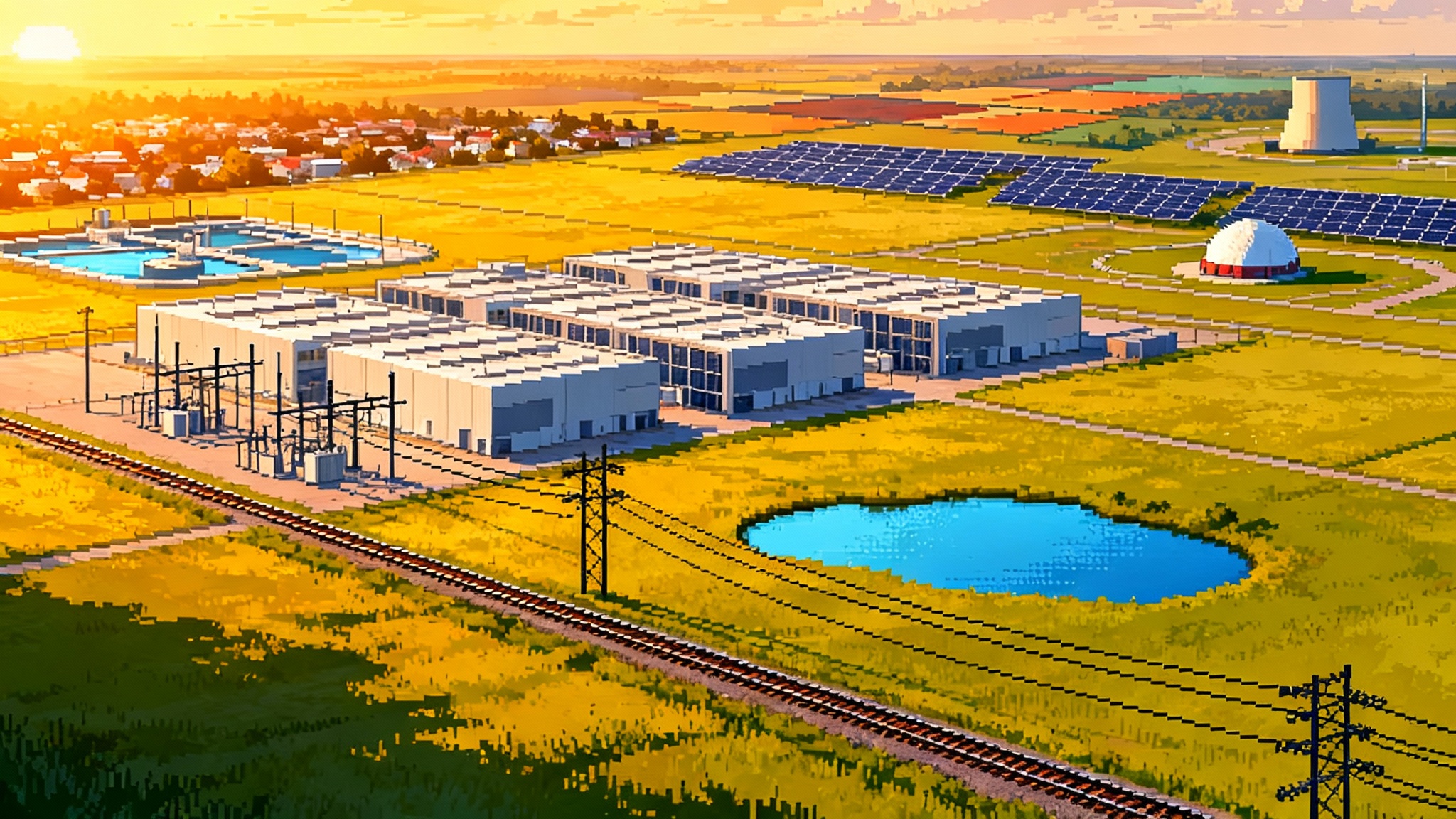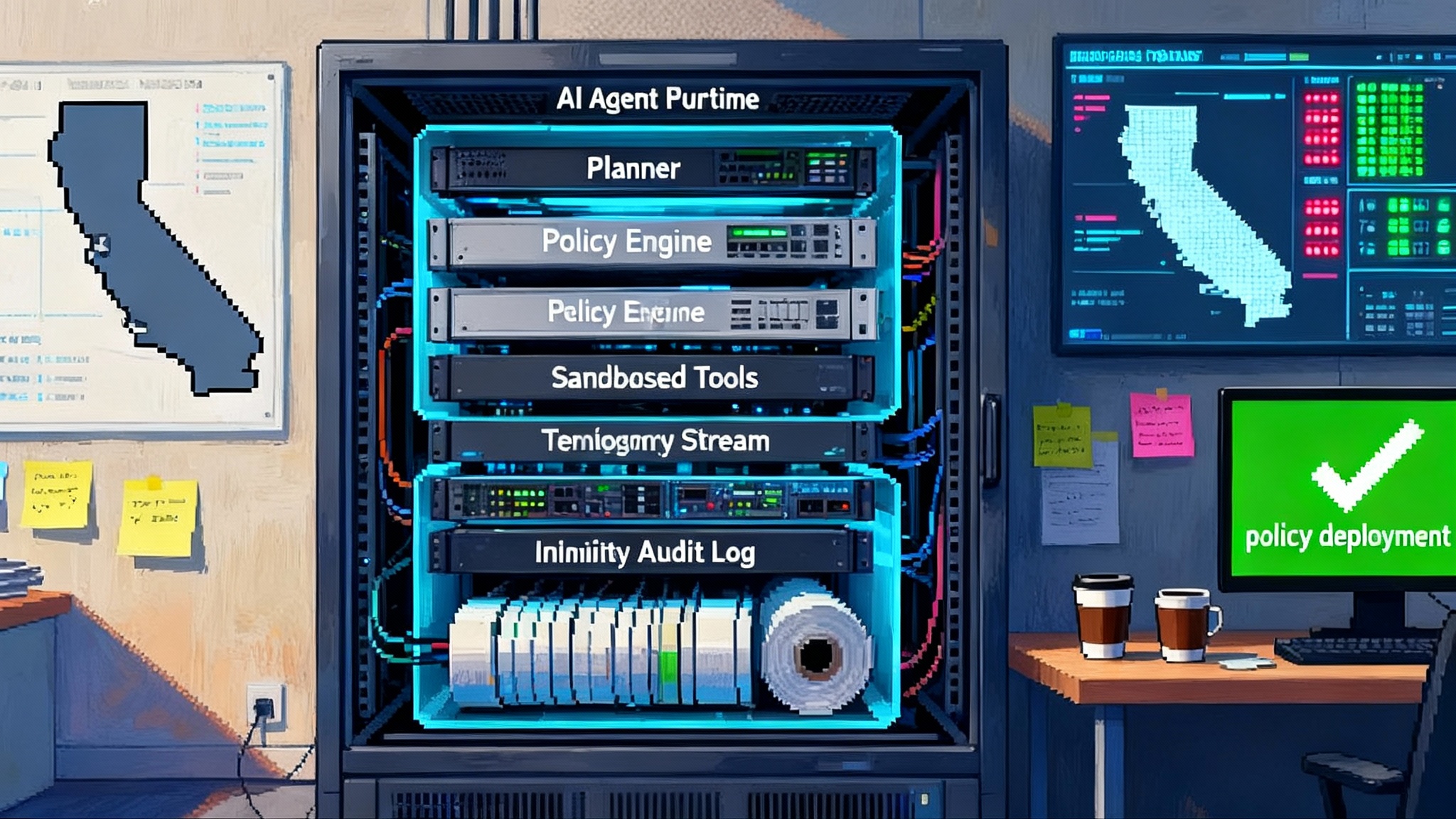The Next AI Race: Watts, Permits, Land, and Leverage
AI’s center of gravity is shifting from model tricks to megawatts. Winners will secure power, permits, and sites, and publish watts per token as a product feature. This is the reactor to runtime playbook.

From Chips to Circuits: Why Power Now Sets the Pace
If the last era of AI was measured in parameters and benchmark charts, the next era will be measured in megawatts, queue positions, and water rights. Markets are starting to price that reality. Infrastructure stories dominate headlines. Energy programs and local permitting regimes are becoming as strategic as model design. The center of gravity is moving from abstract compute to concrete capacity at the substation.
This is not a metaphor. It is an operating model. When electricity is the largest line item in the cost of intelligence, the competitive frontier shifts. The winners will be the organizations that can pull steady power at predictable prices in specific places and can prove they have the legal and physical rights to move electrons and water. That is sovereignty over watts, permits, and terrain.
A kilowatt hour delivered at the right node is worth more than a kilowatt hour promised on paper.
Intelligence as an Energy Policy
For a decade the scoreboard celebrated tokens and parameter counts. Today the unit that sets the pace is the watt. Treat watts as a first class product input and a first class product constraint.
- Sovereignty over electrons: secure firm supply through long term power purchase agreements, on site or adjacent generation, and real interconnection capacity that matches scale targets.
- Sovereignty over permits: obtain land use approvals, water rights, environmental compliance, and transmission upgrades that can withstand litigation and local politics.
- Sovereignty over terrain: choose parcels near substations and waterways, with rail or barge access for heavy equipment, and rights of way that shorten build times.
The premium is deliverability. In grids where congestion and curtailment rise, deliverable energy at the correct node becomes a form of intellectual property. Queue position and capacity rights are turning into competitive moats.
Why Watts Are the New Parameters
Parameters used to signal ambition. A stronger signal now is guaranteed baseload plus fast ramping headroom. Power shapes the tempo of training cycles and the trust customers can place in latency commitments.
- Throughput: Tokens per second are a function of energy per token and the elasticity of supply, not just the size of the cluster.
- Reliability: Fine tuned models do little if brownouts throttle inference backlogs. Service level agreements are only as real as power level agreements.
- Cost: The marginal cost of inference converges toward the marginal cost of electricity. Locking carbon free megawatt hours at stable prices over long tenors becomes a defensible advantage.
The stack is getting physical. Compute is evolving from a cloud shaped abstraction into a chain that starts at the breaker panel and the switchyard.
Reactor to Runtime: The New Vertical Stack
A modern AI platform increasingly spans generation to user request. The layers are familiar in principle, unfamiliar in combination.
- Generation: nuclear, hydro, geothermal, solar, wind, and hybrids that pair firm baseload with storage. The choice is not only environmental. It defines reliability curves, cooling strategies, and expansion options.
- Interconnection: queue positions, capacity rights, and substation upgrades that are structured early so construction outruns lawsuits rather than the other way around.
- Data center: heat reuse, water treatment, and siting geometry integrated with the generation plan. Liquid cooling becomes civil engineering as much as chip design.
- Orchestration: schedulers tuned for power awareness. Training windows align with seasonal capacity. Inference spills over to regions with surplus.
- Runtime: pricing reflects watts per token and carbon per inference. These metrics are presented as features customers can choose, not externalities to hide.
Vertical integration does not have to mean owning every bolt. It means lining up agreements and design choices so electrons, water, and bits flow as one system. The hard part is not one giant bet. It is a hundred local and legal decisions that add up to a buildable plan.
Municipal Compute Federalism
Cities, water districts, and co ops will compete to host compute the way they once bid for factories. Call it municipal compute federalism. The unit of competition is watts, water, and rights of way.
- Watts: local utilities craft tariffs for 24 by 7 clean supply and flexible curtailment rules that align with training cycles. Utility boards become kingmakers.
- Water: towns that guarantee reclaimed water for cooling and can defend a drought plan will beat those that cannot. Secure water is as precious as secure power.
- Rights of way: communities that pre permit conduit corridors and provide automatic permits for non disruptive trenching accelerate fiber and grid tie in timelines by quarters, not weeks.
The prize is bigger than tax revenue. Waste heat can lower local heating bills. Dividend programs can flow directly to households. Workforce pipelines can turn into durable operations jobs. The catch is political. Social license must be earned with dividend structures that are legible, measurable, and enforced.
For a policy view of how law moves inside the loop, see our essay on regulation becomes runtime.
Bring Your Own Generation Becomes Strategy
Bring your own is no longer just for devices. Bring your own generation is becoming the default for serious builders because co located power compresses supply risk and opens new optimization levers.
- Firm plus flexible: pair a small modular reactor or geothermal unit with batteries and on site solar. Firm power covers the baseline. Storage handles ramps. Solar reduces daytime draw.
- Heat reuse by design: route liquid cooling loops to district heating, greenhouses, or industrial processes. Show residents how waste heat lowers bills.
- Queue shortcuts: in some regions, co located generation follows a different interconnection pathway than load only projects. Paperwork advantages map directly into time to revenue.
The old playbook said scale a region with a hyperscale provider. The new playbook says secure a substation, a water source, and a package of permits, then stand up the region with a partner that builds like a utility.
Power Aware AI Design
The product shift looks small and turns out to be large. Publish power as a first class metric.
- Instrumentation: add per request power estimation at runtime. Tie it to tenant billing so customers can choose low power modes or faster high power modes.
- Budgeting: set power budgets for training runs with checkpointing tied to grid alerts. When the grid is tight, the job pauses or moves.
- Exposure: put a power panel in the dashboard. Show live watts per token and carbon per inference. Make this a sales feature for enterprise procurement.
Teams that bring power into design meetings discover different priorities. Compression and caching move from afterthoughts to headliners. Routing becomes carbon aware by default. The platform story becomes part performance, part resource stewardship.
Ethics That Fit Inside a Substation
Ethics debates often get abstract. The grid forces specificity. If your system requires a new substation, you owe the town clear standards that fit inside the fence.
- Prefer clean baseload: nuclear, hydro, or geothermal where practical. If gas is required, design for later carbon capture and chart a path to clean firm supply.
- Share upside locally: codify a dividend tied to metered output. Set aside capacity credits for community facilities. Publish checks and audits on a regular cadence.
- Water and heat: use reclaimed water when available. Disclose expected consumption under heat waves. Route waste heat into district systems where it pencils out.
You can argue about general intelligence in the abstract. Or you can engineer a project that leaves a community stronger. In this cycle, the latter wins permits and social license.
Policy Levers That Tilt the Map
Policymakers can move faster by making it simpler to build clean and build local.
- Pre permit energy parks: allow co located generation and compute as a single project type. Bundle environmental reviews so schedules run in parallel.
- Standardize heat reuse easements: if conduit paths exist on paper, they get built on the ground.
- Offer clean capacity credits: tie incentives to resilience metrics such as peak reduction and storm performance.
Sequencing is the secret. Projects die when one permit lags a year. Projects live when several approvals move together.
The Interconnection Bottleneck Is the New Hiring Bottleneck
Five years ago, talent was the scarcest resource in AI. Today it is interconnection. Getting capacity at the right node can take years. Queue position must be treated with the same rigor once applied to recruiting.
Practical moves:
- Early studies: fund power flow studies and publish them with utility partners to reduce uncertainty and build trust.
- Dual site strategy: hold two sites in different balancing authorities. Treat it as redundancy for permits.
- Storage as a diplomat: use battery storage to reduce peak draw and improve the project’s value to the system operator. Batteries can be permits in a box.
If you need a primer on current policy shifts, review the latest FERC interconnection reforms that try to unclog queues and reward ready to build projects.
Concentration Risk and the Antitrust Lens
Reactor to runtime stacks raise familiar questions about concentration. The answer is not to ban vertical models. The answer is to define guardrails that protect innovation and resilience.
- Open interconnects: require fair access to excess capacity at substations that received public support.
- Data portability: portability rules keep customers from being trapped behind bespoke power compute bundles.
- Municipal equity: reserve a portion of capacity for local institutions such as libraries, schools, and clinics.
These measures do not hobble builders. They create a stable compact with communities and regulators that unlocks larger projects.
A Six Month Playbook for Builders
If you are planning a new training cluster or launching a fresh inference product, here is a practical checklist.
- Site search: pick regions where your load profile matches local supply. Look for underused transmission, not only low energy headlines.
- Power contract: secure a blend of firm and flexible megawatt hours with a reasonable price collar. You are buying throughput and predictability, not a single low price.
- Water plan: budget for heat waves. Include a contingency line for water trucking and publish the trigger conditions.
- Heat reuse: line up a letter of intent with a specific off taker before you pour concrete. Heat reuse is real when there is a customer with a bill to lower.
- Community dividend: describe the cash flow, the bank account, and the auditor. Trust is specific.
- Power aware software: add watts per token and carbon per inference to your product spec. Route work toward the cleanest region by default.
For the networking and memory side of this equation, see why the AI arms race is bandwidth. Platform performance is a braid of electrons, fiber, and packaging.
Forecast: A Near Term Reset in Platform Power
The platforms that matter next will not look like the ones that dominated the last decade.
- Vertically integrated stacks: companies that control slices from generation to runtime will set the reliability bar. They will sell not only models but volts and degrees Celsius at the fence line.
- Municipal compute zones: cities will market megawatts and water reuse like they once marketed industrial parks. Expect timed auctions that bundle land, power, and fiber.
- Power aware products: buyers will select models partly by energy profile. Low power modes, carbon aware routing, and guaranteed clean supply will appear next to accuracy and latency.
Research will follow the energy signal. Schedulers, quantization strategies, and retrieval systems will adapt to live power conditions. The model becomes part of a cyber physical system whose behavior changes when clouds pass over solar arrays or a hydro unit ramps up. For a broader platform view, consider why model pluralism wins the platform war.
Build Boldly and Measure What Matters
Acceleration does not have to ignore costs or communities. The better posture is precise and responsible. Prefer clean baseload where practical. Return dividends locally. Measure and publish the power you use. These are not slogans. They are blueprint lines and dashboard elements.
Teams that align with the grid will earn cheaper, cleaner, and more bankable megawatt hours. Cities that align with builders will gain durable jobs, lower heating bills, and infrastructure upgrades funded by private balance sheets. A shared outcome emerges when incentives meet in the middle of a substation rather than in a press release.
Closing: The Grid Sets the Tempo
Debates about whether scale alone delivers general intelligence will continue. The tempo, however, is set elsewhere. The cadence of the field is moving from parameter counts to project timelines for substations, cooling loops, and rights of way. The teams that master watts, permits, and terrain will define what is possible. If you want to build the next chapter of intelligence, bring your own generation, pay your dividend forward, and hold design meetings next to the switchgear. That is how progress will be wired.








